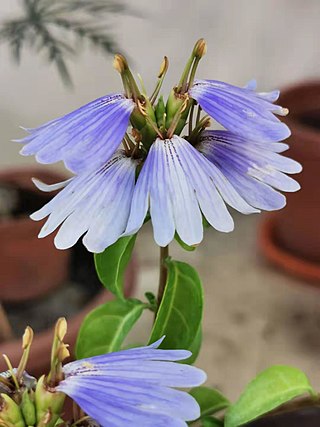
Acanthaceae is a family of dicotyledonous flowering plants containing almost 250 genera and about 2500 species. Most are tropical herbs, shrubs, or twining vines; some are epiphytes. Only a few species are distributed in temperate regions. The four main centres of distribution are Indonesia and Malaysia, Africa, Brazil, and Central America. Representatives of the family can be found in nearly every habitat, including dense or open forests, scrublands, wet fields and valleys, sea coast and marine areas, swamps, and mangrove forests.

Justicia is a genus of flowering plants in the family Acanthaceae. It is the largest genus within the family, with over 900 accepted species. They are native to tropical to warm temperate regions of the Americas, India, and Africa. The genus serves as host to many butterfly species, such as Anartia fatima. Common names include water-willow and shrimp plant, the latter from the inflorescences, which resemble a shrimp in some species. The generic name honours Scottish horticulturist James Justice (1698–1763). They are closely related to Pachystachys.

Aphelandra is a genus of over 200 species of flowering plants in the family Acanthaceae, native to tropical regions of the Americas.

Thunbergia is a genus of flowering plants in the family Acanthaceae. It includes 150 species native to tropical and subtropical regions of sub-Saharan Africa, Madagascar, southern Asia, New Guinea, and Australia. Thunbergia species are vigorous annual or perennial vines and shrubs growing to 2–8 m tall. The generic name honours the Swedish naturalist Carl Peter Thunberg (1743-1828).

Acanthus is a genus of about 30 species of flowering plants in the family Acanthaceae, native to tropical and warm temperate regions, with the highest species diversity in the Mediterranean Basin and Asia. This flowering plant is nectar producing and depends on butterflies, such as Anartia fatima, and other nectar feeding organisms to distribute its pollen. Common names include Acanthus and bear's breeches. The generic name derives from the Greek term ἄκανθος (akanthos) for Acanthus mollis, a plant that was commonly imitated in Corinthian capitals.

Barleria is a genus of plants in the family Acanthaceae. It includes 303 species native to the tropics and subtropics, including the Americas from Mexico to northern South America, sub-Saharan Africa, Egypt and the Arabian Peninsula, the Indian subcontinent, Indochina, southern China and Taiwan, parts of Malesia, and New Guinea.

Anisacanthus is a genus of flowering plants in the bear's breeches family, Acanthaceae. The generic name is derived from the Greek words ανισος (anisos), meaning "unequal," and ακανθος (acanthos), meaning "thorn." Members of the genus are native to tropical and subtropical regions of the Americas. They are commonly known as desert honeysuckles, though this term is shared with the genus Ancistranthus, and is something of a misnomer as true honeysuckles belong to the family Caprifoliaceae. Anisacanthus species are sometimes cultivated for use in xeriscaping.

Poikilacanthus is a genus of flowering plants in the family Acanthaceae. It includes 13 species native to the tropical Americas, ranging from central Mexico to northern Argentina.

Andrographis is a genus of flowering plants in the family Acanthaceae. They may be generally known as the false waterwillows, and several are called periyanagai.

Sanchezia is a genus of the plant family Acanthaceae. It contains 45 species. Members of this genus are shrubs, rarely small trees or herbs, occurring in the lowlands of tropical South and Central America. A close relative is Suessenguthia, which looks quite similar.

Anisotes is a genus of Afrotropical plants in the family Acanthaceae. The genus is morphologically similar to Metarungia, from which it differs mainly in the dehiscence of the fruit capsule, and the nature of the placenta. Placentas remain attached to the inner surface of fruit capsules in Anisotes.

Odontonema, the toothedthreads, is a genus of flowering plants in the family Acanthaceae. It includes 32 species native to the tropical Americas, ranging from Mexico to Peru and southeastern Brazil.

Sclerochiton is a genus of flowering plants in the family Acanthaceae. It includes 18 species native to tropical and southern Africa.

Tetramerium is a genus of plants belonging to the family Acanthaceae. It is found in the Americas, ranging from the southwestern United States to Bolivia, especially in tropical dry forests. Christian Gottfried Daniel Nees von Esenbeck first described the genus in 1846 after collecting two species on the journey of HMS Sulphur.

Pachystachys is a genus of 12 species of flowering plants in the family Acanthaceae, native to rainforest in the Caribbean and Central and South America. They are evergreen perennials and shrubs bearing prominent terminal spikes of flowers with brightly coloured bracts.

Bravaisia is a genus of plants in the family Acanthaceae. It includes three species of shrubs or trees native to Mexico, Central America, Colombia, Venezuela, Cuba, and Trinidad.

Schaueria is a genus of flowering plants in the family Acanthaceae. They are endemic to Brazil, from Bahia to Rio Grande do Sul. They are characterized by small elongated white or yellow flowers and narrow to thread-like green or yellow bracts. They are found mainly in rain forests, semi-deciduous mountain forests, and restingas. They are pollinated by bees and hummingbirds.
Chamaeranthemum is a genus of flowering plants belonging to the family Acanthaceae. It includes four species native to the tropical Americas, including Costa Rica, Peru, and southern and southeastern Brazil.

Herpetacanthus is a genus of flowering plants belonging to the family Acanthaceae. It includes 21 species native to the tropical Americas, ranging from Honduras to Panama in Central America, and from Ecuador and Peru to Bolivia, northern and eastern Brazil, Suriname, and French Guiana in South America.

Trichanthera is a genus of flowering plant in the family Acanthaceae, native to central and southern tropical America. The genus was first described by Carl Sigismund Kunth in 1845.



















